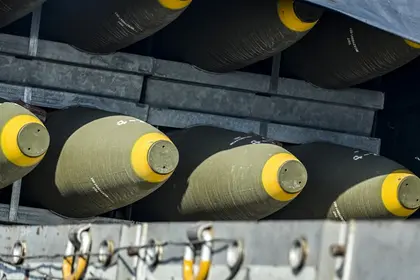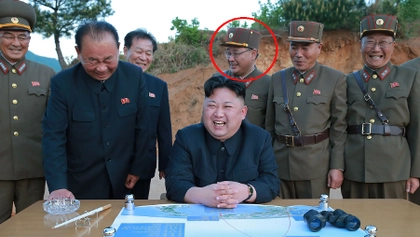Officials in countries that have promised to feed Kyiv’s cannon are claiming the problem really isn’t so bad or are split on whose factories should fill lucrative orders for hundreds of thousands of shells and mortar rounds badly needed by Ukraine’s gunners.
Sabrina Singh, Deputy Press Secretary for the US Department of Defense, in a Nov. 21 briefing told Washington journalists recent reports of American shell deliveries to Ukraine plummeting following a Pentagon decision to prioritize shipments to Israel were, she said, simply wrong.
JOIN US ON TELEGRAM
Follow our coverage of the war on the @Kyivpost_official.
Asked by a Voice of America reporter to comment on reports that deliveries of 155mm artillery shells to Ukraine had fallen by more than 30 percent since the Israel-Hamas war began and that Ukrainian officials had confirmed the drop, Singh responded:
“Yeah, look, I would push back on that assertion. We have been able to supply Ukraine with what it needs during its counteroffensive and will continue to supply with what it needs as we head into winter. We are able to do that and we are able to support Israel with what it needs to defend itself in its war with Hamas. We feel confident we can do both, and we’re going to continue to do both.”
The major US television broadcaster ABC News on Tuesday reported that thousands of 155mm artillery shells that were designated for Ukrainian forces have been diverted to Israel and quoted an unnamed Ukrainian official as stating: “We’re in big trouble – basic munitions are not coming.”

‘Wild Hornets’ Latest Development Will ‘Sting’ Russian Shahed Drones
Ukrainian soldiers deployed to or recently returned from the Kharkiv, Donetsk and Zaporizhzhia sectors told Kyiv Post in telephone conversations and text messages that guns backing positions where they were fighting appeared to have sufficient ammunition to fire from time to time but crushing, long-term barrages sufficient to blast Russian defenders out of their positions are not an option.
Russian military information platforms likewise report that NATO-standard cannon deployed with the Armed Forces of Ukraine (AFU) enjoy a range and accuracy advantage over Russian artillery, but, Kyiv’s gunners rarely fire more than a few shells at a time.
At the outset of the Russian invasion in February 2022, President Volodymyr Zelensky’s first ask to Western allies was to “send ammunition,” and since then he has repeatedly identified artillery firepower as critical to Ukraine’s capacity to defend itself.
On Nov. 16 the Ukrainian leader singled out the supply chain for the NATO-standard 155mm howitzer shell – month by month usually the most common and tactically important line item in US military assistance to Ukraine – as having shrunk dramatically in recent weeks.
“Our deliveries have decreased. They really slowed down. It’s not like the US said: We don’t give Ukraine any. No! It’s just that everyone is fighting for [stockpiles] themselves. This is life. I’m not saying that this is positive, but this is life, and we have to defend what’s ours,” Zelensky told reporters in Kyiv.
Most military analysts estimate the AFU currently fields and operates around 650-700 NATO-standard artillery systems, of which about 500 fire the 155mm shell and 200 use the 105mm shell.
According to open sources, the AFU shoots off 2,000 to 3,000 NATO-standard shells in a typical day of fighting and would need at least two or three times that amount of ammo to fully dominate the length of the war’s 1,500 km-long fighting line or have a reasonable chance of breaking Russian defenses in attack sectors.
Actual shell expenditure volumes, and shell stockpiles, are AFU military secrets.
German Defense Minister Boris Pistorius on Nov. 14 at a Brussels meeting admitted, for the first time publicly for a senior European official, that the EU will miss its target of supplying Ukraine with one million NATO-standard artillery shells and missiles by March 2024.
The EU’s chief diplomat, Josep Borrell, at the same meeting, said the bloc had delivered about one-third of a commitment made in March 2023.
The main problem, he claimed, was that although Europe contains sufficient arms manufacturing capacity to keep the promise made to Ukraine, previous orders by national militaries and non-NATO countries were taking precedence over the promise to Kyiv.
Thierry Breton, European Commissioner for Internal Market, told reporters that by the spring of 2024, EU manufacturers will be able to produce one million artillery shells a year and by the end of 2024 will reach a capacity of 1.3 to 1.4 million shells. Europe can keep its promise to Ukraine provided EU member states have “the political will” to prioritize ammunition for Ukraine over deliveries to the customers, he said.
Après avoir mobilisé les industriels de #défense 🇪🇺, notre capacité industrielle a déjà crû de 20 à 30%
— Thierry Breton (@ThierryBreton) November 14, 2023
L’objectif d’une capacité de production UE de 1 million de munitions/an d’ici au 1er semestre 24 sera tenu
Désormais: prioriser production actuelle pour 🇺🇦 & passer contrats pic.twitter.com/vkuFK0F2ei
But Breton’s confidence in European manufacturing capacity is not shared universally. Ukrainska Pravda, Ukraine’s oldest news weekly, on Nov. 17 cited both Latvian President Edgars Rinkevics and Ukrainian Foreign Minister Dmitro Kuleba as unconvinced EU arms manufacturers could deliver as Breton hoped. Kyiv must seek alternate sources of NATO standard artillery ammo and waiting on Europe was dangerous, the magazine said.
At the same time, the EU leadership is wrangling about how many artillery shells should be made by which factory. Meanwhile, the Kremlin ordered, and the Russian military has already received by expedited rail shipment, at least one million artillery shells from North Korea, the article said.
US capacity to fill the European shell gap is also under question, Singh admitted, because funding for American military assistance to Ukraine has almost run out and, without further Congressional approval money for arms, deliveries to Kyiv will dry up.
“But, let me just take this as a moment, to reiterate, that we need Congress’s help,” Singh said. “We cannot do this without… Congress passing the supplemental bill which we submitted months ago, and that was in need for immediate emergency assistance, and that’s not just for Ukraine, that’s also for Israel, for the Indo-Pacific.
“And so, the only way that we can continue to support Ukraine is if Congress passes that urgent supplemental bill that we requested.”
AFP material was used in this article.
You can also highlight the text and press Ctrl + Enter






